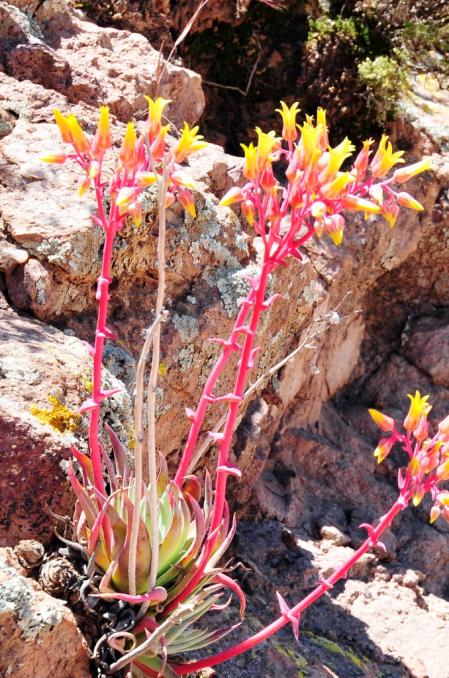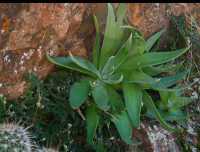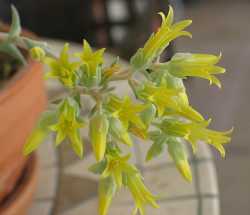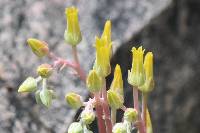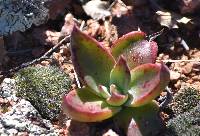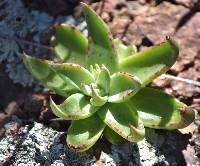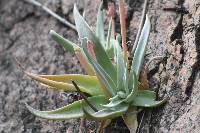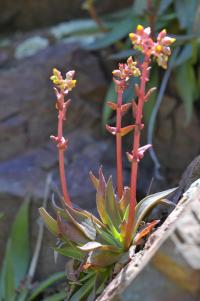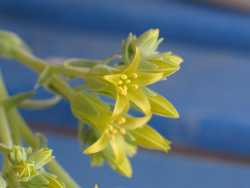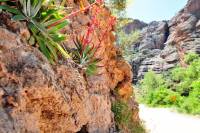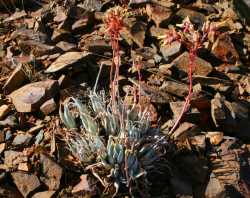
|
|
|
|
Family: Crassulaceae
Panamint Live-Forever, more...Panamint liveforever
|
Caudices simple or apically branched, cespitose, 0.1-5 × 1-3 cm, axillary branches absent. Leaves: rosettes 1-2, not in clumps, 10-25-leaved, 3-12 cm diam.; blade pale green, oblong-lanceolate, tapering from base or slightly wider near middle, 3-15 × 0.5-2.5 cm, 1.5-6 mm thick, base 0.5-2.5 cm wide, apex narrowly acute, surfaces not farinose, glaucous at least when young. Inflorescences: cyme (red), 2-3-branched, obpyramidal; branches not twisted (flowers on topside), simple or 1 times bifurcate, (5-20 cm wide); cincinni 2-3, 2-20-flowered, circinate, 1-18 cm; floral shoots 5-40 × 0.2-0.9 cm; leaves 5-20, ascending, triangular-lanceolate, 5-70 × 3-10 mm, apex acute. Pedicels erect, not bent in fruit, 5-20 mm. Flowers: calyx 4-8 × 4.5-7 mm; petals connate 1-4 mm, bright to greenish yellow or red-marked, 8-20 × 9-20 mm, apex acute, tips often outcurved; pistils connivent, erect. Unripe follicles erect. The three geographically isolated subspecies of Dudleya saxosa differ mostly in size of parts and in level of ploidy.
Plant: perennial herb; rosettes solitary or few, 3-12 cm wide, of 10-25 erect or ascending leaves, on short stem 1-3 cm thick Leaves: at first glaucous, later green, oblong-lanceolate, tapering from base or slightly wider near middle, narrowly acute, 3-20 cm long, 0.5-2.5 cm wide, 1.5-6 mm thick, the base 0.5-2.5 cm wide INFLORESCENCE: FLORAL STEMS 0.5-4 dm tall, 2-6 mm thick, red, the 5-15 leaves ascending, triangular-lanceolate, acute, the lowest 0.5-7 cm long, 3-10 mm wide; CYMES red, of 2-6 ascending branches 1-12 cm long, 2-12-flowered; pedicels erect, 0.5-2 cm long, straight Flowers: FLOWERS: sepals 2.5-7 mm long; corolla yellow or red-marked, 9-20 mm long, the tube 1-4 mm long Fruit: FOLLICLES many-seeded. SEEDS narrowly ovoid, brown, striate, to 1 mm long REFERENCES: Moran, Reid. 1994. Bixaceae. J. Ariz. - Nev. Acad. Sci. Volume 27, 190-194. FNA 2009, Jepson 2012 Duration: Perennial Nativity: Native Lifeform: Succulent General: Succulent perennials, caudices to 5 cm tall and 3 cm wide, reddish, especially when in flower, simple or apically branched, (axillary branches absent), plants growing in dense tufts (cespitose), herbage not farinose, covered with a whitish or bluish waxy coating (glaucous), at least when young. Leaves: Alternate, with 1-2 basal rosettes (not in clumps), rosettes 10-25-leaved, 3-12 cm in diameter, blades pale green, oblong-lanceolate, 3-15 cm long, 0.5-2.5 cm wide, and 1.5-6 mm thick, tapering from the base or slightly wider near the middle, bases 0.5-2.5 cm wide, apices narrowly acute, cauline leaves or bracts of the infloresence 5-20 in number, ascending, triangular-lanceolate, 5-70 mm long and 3-10 mm wide, with acute tips. Flowers: Bright to greenish yellow to orange-red or or red-marked, conspicuous when in bloom, petals connate or fused at the base for 1-4 mm, erect and spreading at the tips, 8-20 mm long and 9-20 mm wide, with acute apices, the tips often curved outwards, sepals triangular (deltate), 4-8 mm long, with acute tips, calyx 4-8 mm long and 4.5-7 mm wide, pistils convergent and erect, inflorescences with red stems, flowers in 2-3 branched, obpyramidal cymes 5-20 cm wide, branches not twisted with flowers on the topside, simple or branched into 2 forks (bifurcate), these with 2-3 tightly coiled (circinate) or scorpoid-like (cincinni) flowering stems, 2-20-flowered, 1-18 cm long, floral shoots 5-40 cm long and to 1 cm wide, pedicels erect and not bent in fruit, 5-20 mm long. Fruits: Whorls of follicles, each follicle dehiscent along an adaxial suture, unripe follicles erect. Seeds 1-20 or more, brown, narrowly ovoid, longitudinally and finely cross-ribbed. Ecology: Unknown. Distribution: Arizona, California. Notes: This species is not currently recognized as occurring in Arizona by USDA Plants and cannot be found in older versions of Kearney and Peebles, however, Jepson 2012 does note this species occurring in Arizona, but provides no other ecology data as of May 2012. Ethnobotany: Specific uses for this species are unknown, but other species in the genus have uses; leaves and flowering stems eaten raw. Synonyms: None Editor: LCrumbacher2012 Etymology: Dudleya is named for William Russel Dudley (1849-1911), first professor of botany and head of the Botany Department at Stanford University, and saxosa means "full of rocks," hence growing among rocks. |
|
|
|
This project was made possible in part by the Institute of Museum and Library Services [MG-70-19-0057-19].
Powered by Symbiota

